20 Interesting & Fun Harris Hawk Facts You Never Knew
Last Updated on
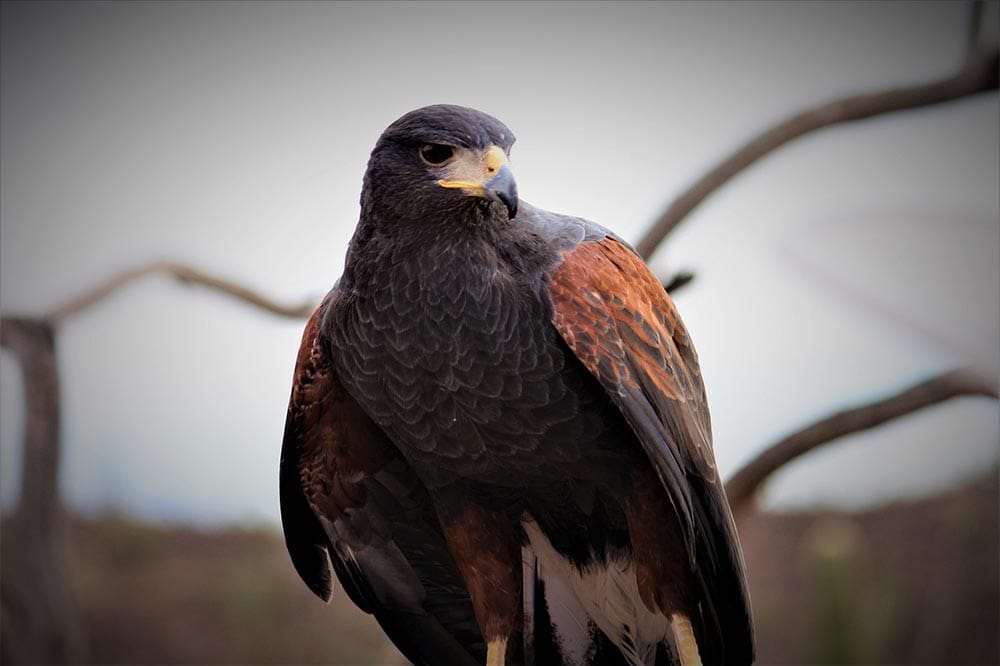
You may not be familiar with the Harris Hawk (Parabuteo unicinctus) since it doesn’t have an extensive range like other raptors, such as the Red-Tailed Hawk. Nevertheless, it is a striking bird with a black tail and wingtips. The bird has white undertail coverts and tips on its large tail. It’s similar in appearance to the Red-Shouldered Hawk or Northern Harrier. However, that’s where many of the comparisons end.

The 20 Interesting and Fun Harris Hawk Facts You Never Knew
Many raptors have colloquial names that often reflect some aspect of their behavior. There is the sparrow hawk denoting the American Kestrel and the chicken hawk for the Cooper’s Hawk. The other moniker for the Harris Hawk is the wolf hawk. It recognizes the unusual cooperative hunting style of this bird.

2. The Harris Hawk’s Population Has Been Steadily Decreasing
The International Union for Conservation of Nature and Natural Resources (IUCN) lists this raptor as a species of least concern. However, it hasn’t been seen in one of its typical haunts in the Lower Colorado River Valley. Its status is uncertain in Suriname and Panama. Unfortunately, poaching for falconry remains a threat. Climate change will likely take a heavy toll on its habitat, too.
3. The Harris Hawk Is One of the More Sociable Raptors
Raptors, as a group, are intelligent birds. This fact has made the Harris Hawk a popular choice for falconry. Perhaps, its cooperative hunting style plays a role in this task. However, make no mistake—this raptor knows who rules the roost. That’s why some people have given these birds another task as an abatement hawk. This means that the hawk is trained to swoop in and scare away pest birds.
4. The Harris Hawk’s Range in the United States Is Isolated
Many raptors have relatively large home ranges. The Harris Hawk’s territory is about 2 square miles. Nevertheless, you’ll only find this bird in pockets in Arizona, Texas, and New Mexico. You’re more likely to encounter it in Mexico and several countries in South America where it is a year-round resident. This species is non-migratory for the most part.
5. Harris Hawks Take Advantage of Their Surroundings for Nesting Spots
We mentioned the raptor’s range being in some parts of Arizona already. When you think of Arizona, one of the first things that may come to your mind is mesquite trees and saguaro cacti. If so, you’re on the same page as the Harris Hawk. It will also nest in cliffs or on platforms. It just needs a clear view of its surroundings to find food and keep an eye out for predators, such as Great Horned Owls.
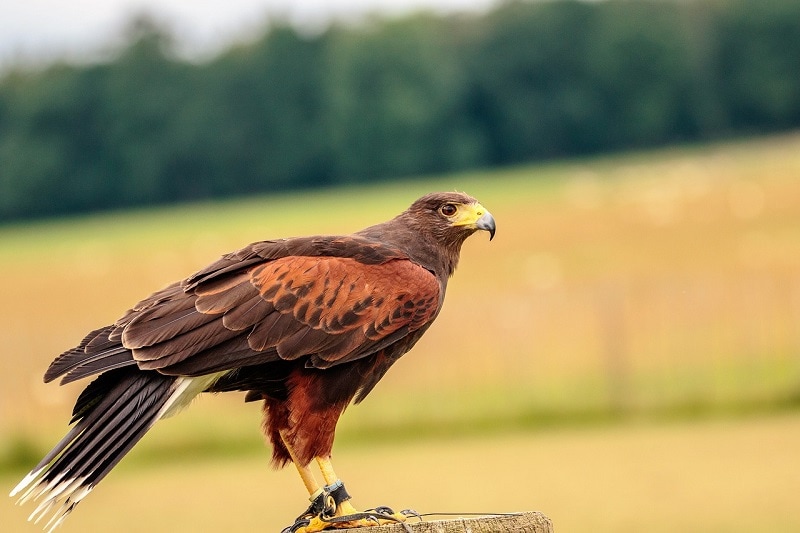
6. John James Audubon Named the Harris Hawk
The famed naturalist named the Harris Hawk after his ornithological companion Edward Harris. Harris was a philanthropist and supported Audubon’s work financially. His claim to fame was bringing the Percheron horse to America. The French breed is a hardworking and intelligent animal that makes an excellent draft horse. He also lent his name to Harris’s antelope squirrel and Harris’s sparrow.
7. There Are Three Subspecies of the Harris Hawk
The three subspecies identified by the Integrated Taxonomic Information System (ITIS) are Parabuteo unicinctus harrisi, Parabuteo unicinctus unicinctus, Parabuteo unicinctus superior. The differences are physical, often the result of genetic variations that occur in isolated populations. However, ITIS considers the third one invalid.
8. The Harris Hawk Has Some Unusual Nesting Habits
Hawks are usually solitary nesters, sometimes sharing parental responsibilities with their mates. The Harris Hawk breaks all the rules. It will handle these responsibilities in groups. This comes in handy for the females because the others may feed the young and defend the nests as they incubate and care for the clutches of eggs. Surprisingly, these birds may also have more than one brood of chicks a year.
9. The Harris Hawk Hunts More Like Its Namesake Than a Raptor
We mentioned how the wolf hawk was the other name for this species. It’s not just because the birds hang out together in a pack. They also hunt in a way that resembles this mammalian predator, with others in the group doing different tasks. It’s worth noting that they sometimes will catch their prey while flying, which isn’t unusual for these raptors and is something that Blue Jays also exhibit.
10. One Bird Broke the Species Longevity Record
Like other top predators, Harris Hawks are relatively long-lived, usually living up to 15 or more years in the wild based on bird-banding data. Of course, captivity takes away the challenges that a species may face. The oldest Harris Hawk made it to the ripe old age of 25 years.
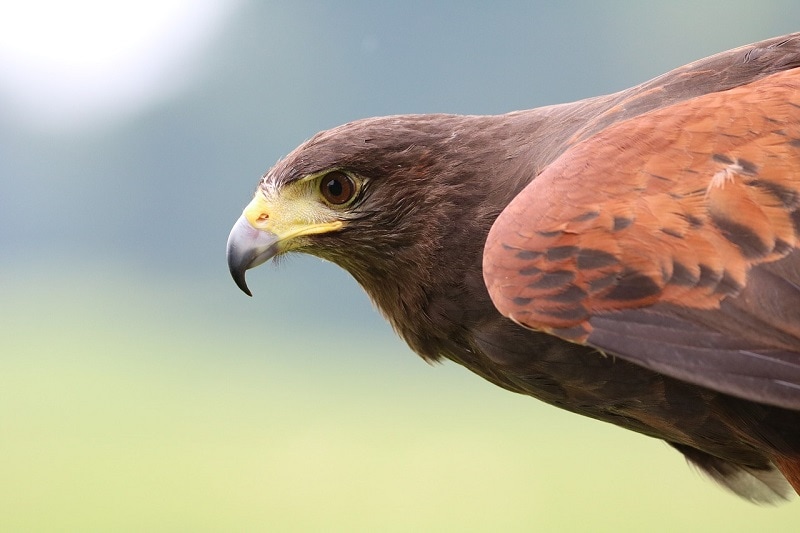
11. The Harris Hawk Is Primarily a Carnivore
Like other birds of prey, the Harris Hawk is a carnivore, feeding on various mammals, including rodents, reptiles, and even other birds. These raptors are not above eating carrion birds, either, if times get tough. Some evidence exists that they may even hunt bats at dusk. The diversity and flexibility in its diet give this species an evolutionary edge.
12. That Same Diversity Applies to Its Habitat
The Harris Hawk occupies various habitats from forests to savannas. It makes the best of living in arid places, too. It will also live in wetlands, shrublands, dunes, and swamps. The presence of water is often a primary factor in determining where this bird will live. These hawks may even live near human dwellings and farms because of their tolerance of people.
13. Harris Hawks Communicate in Many Ways
Like many birds, the Harris Hawk has different vocalizations to communicate specific messages. Its main call is a harsh sound that makes it certain this raptor means business if something disturbs or surprises it. It also has chirping calls that belie the fact that it’s a predator when in flight. Its alarm alert is a short, piercing sound. The hawk also uses its wings to communicate with other raptors.
14. The Females Rule the Roost
Female Harris Hawks are up to 30% larger than the males, which makes sense since the female does the incubating. It also means that groups have an alpha female instead of a male. After all, the larger size gives them a competitive edge when hunting or fending off predators.
15. The Harris Hawks Is an Excellent and Talented Flier
You can often identify birds from the ground by how they fly. The Harris Hawk might make this task more difficult. While it will soar, it can also hover. It will even do jaw-dropping aerial dives and fly backward! They are agile in the air and on the ground, sometimes chasing prey down on the ground. Their most dramatic display is their sky dancing, which the male uses to attract a female.
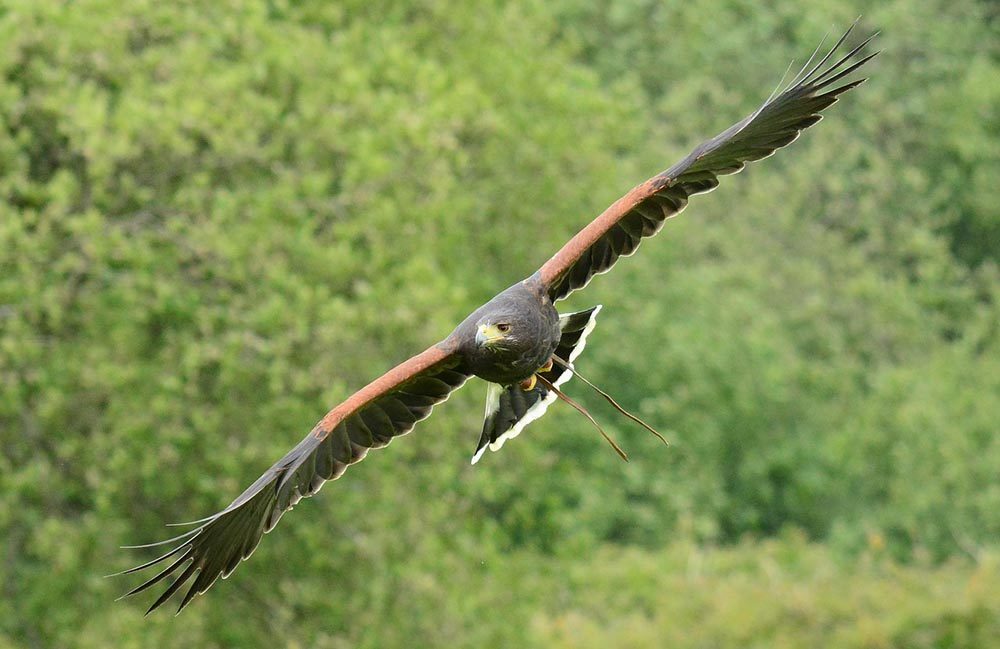
16. Its Species Name Describes Its Habitat
The species name for the Harris Hawk is unicinctus. It comes from the Latin word meaning “uninhabited.” It’s a wise choice, given the places where you may find this bird in the wild. Another interpretation is that it’s a reference to the white band on the end of the raptor’s tail from the Latin word cinctus meaning “girded.”
17. Harris Hawks Are Monogamous
These birds form lifelong relationships with their mates. That’s often true with animals in which the parents make a relatively large investment. Chicks will fledge up to 45 days after hatching. Remember that this species may have more than one brood, meaning they can have up to 15 birds each breeding season.
18. There Are Nearly 1 Million Harris Hawks in the World
The Partners in Flight Database estimates the global population of Harris Hawks at 920,000 birds. Fortunately, it is not fragmented, despite the varying habitats. That fact can ensure us that these amazing raptors will be with us for many years to come.
19. The Harris Hawk Is One of Two Species in Its Genus
The only other raptor in the Parabuteo genus is the White-Rumped Hawk (Parabuteo leucorrhous) of the Andes Mountains in South America. The two species look similar, too, although the latter is primarily black with the same distinctive yellow legs and vulture-like appearance.
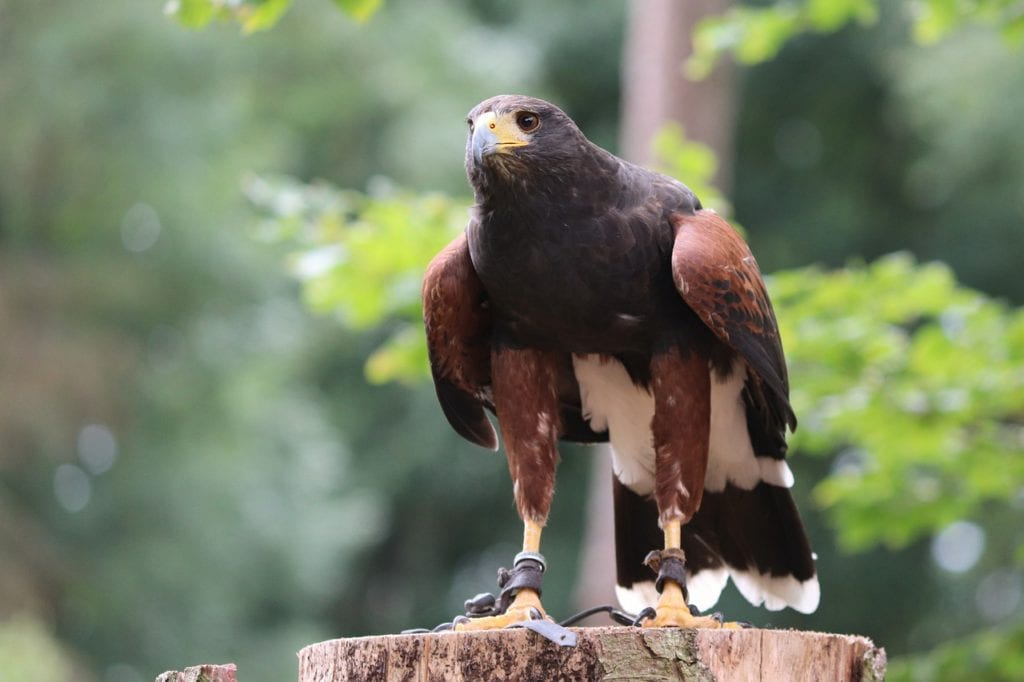
20. The Harris Hawk Has a Presence
The Harris Hawk is a medium-sized raptor that grows up to 23 inches long and weighs over 25 ounces. Its wingspan is 40–47 inches wide. It has the features you’d expect to find in this type of bird, which include its hooked bill, sharp talons, and keen eyesight.

Conclusion
The Harris Hawk stands out from other raptors, breaking all the rules of nature in the process. It’s social when it needs to be for hunting and protecting females in the nest. It will eat whatever is available. It manages to do all these things and survive in sometimes harsh environments. Perhaps, the most interesting thing about this species is how tolerant it is of people. These hawks are truly unique, and there is even more information about them that we have yet to discover.
Featured Image Credit: BeeJo, Pixabay
Table of Contents
- The 20 Interesting and Fun Harris Hawk Facts You Never Knew
- 1. The Harris Hawk Shares Some Traits With Another Social Predator
- 2. The Harris Hawk’s Population Has Been Steadily Decreasing
- 3. The Harris Hawk Is One of the More Sociable Raptors
- 4. The Harris Hawk’s Range in the United States Is Isolated
- 5. Harris Hawks Take Advantage of Their Surroundings for Nesting Spots
- 6. John James Audubon Named the Harris Hawk
- 7. There Are Three Subspecies of the Harris Hawk
- 8. The Harris Hawk Has Some Unusual Nesting Habits
- 9. The Harris Hawk Hunts More Like Its Namesake Than a Raptor
- 10. One Bird Broke the Species Longevity Record
- 11. The Harris Hawk Is Primarily a Carnivore
- 12. That Same Diversity Applies to Its Habitat
- 13. Harris Hawks Communicate in Many Ways
- 14. The Females Rule the Roost
- 15. The Harris Hawks Is an Excellent and Talented Flier
- 16. Its Species Name Describes Its Habitat
- 17. Harris Hawks Are Monogamous
- 18. There Are Nearly 1 Million Harris Hawks in the World
- 19. The Harris Hawk Is One of Two Species in Its Genus
- 20. The Harris Hawk Has a Presence
- Conclusion
About the Author Chris Dinesen Rogers
Chris has been writing since 2009 on a variety of topics. Her motto with all of her writing is “science-based writing nurtured by education and critical thinking.” Chris specializes in science topics and has a special love for health and environmental topics, and animals of all shapes and sizes.
Related Articles:
10 Types of Hummingbirds in Arkansas (With Pictures)
8 Types of Hummingbirds in Nebraska (With Pictures)
5 Types of Hummingbirds in Idaho (With Pictures)
3 Types of Hummingbirds in Mississippi (With Pictures)
8 Types of Hummingbirds in Kansas (With Pictures)
5 Types of Hummingbirds in West Virginia (With Pictures)
5 Types of Hummingbirds in Ohio (With Pictures)
Where Do Nuthatches Nest? Nuthatch Nesting Habits Explained
